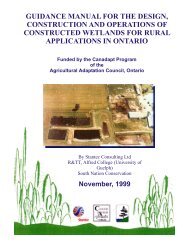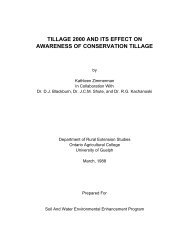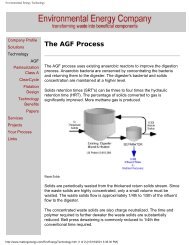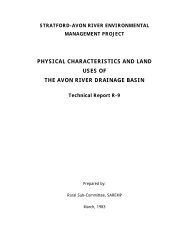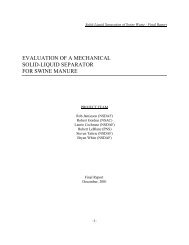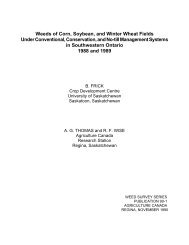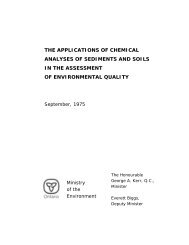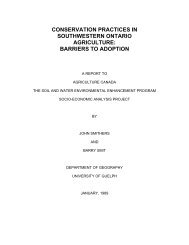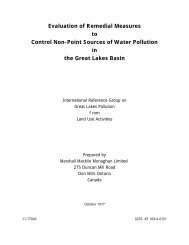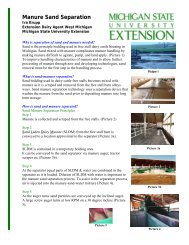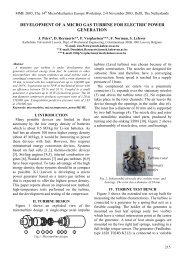Environmental Aspects of Phosphate and Potash Mining United ...
Environmental Aspects of Phosphate and Potash Mining United ...
Environmental Aspects of Phosphate and Potash Mining United ...
You also want an ePaper? Increase the reach of your titles
YUMPU automatically turns print PDFs into web optimized ePapers that Google loves.
Overview <strong>of</strong> <strong>Phosphate</strong> Rock <strong>and</strong> <strong>Potash</strong> <strong>Mining</strong> <strong>and</strong> Beneficiation<br />
Surface brine deposits are exploited using solar evaporation<br />
ponds to concentrate <strong>and</strong> precipitate the<br />
potash. The evaporation ponds are extensive, with<br />
some operations covering in excess <strong>of</strong> 90 square kilometers<br />
<strong>of</strong> l<strong>and</strong> area to produce around 8 million<br />
tonnes <strong>of</strong> potash ore per year.<br />
Washing plant - Office Chérifien des <strong>Phosphate</strong>s (OCP),<br />
Khouribga, Morocco<br />
Conventional mechanized underground mining operations<br />
are the most widely used method for the<br />
extraction <strong>of</strong> potash ore. A variety <strong>of</strong> mining techniques<br />
<strong>and</strong> equipment may be employed depending<br />
on factors such as: the orebody depth, geometry,<br />
thickness <strong>and</strong> consistency, the geological <strong>and</strong> geotechnical<br />
conditions <strong>of</strong> the ore <strong>and</strong> surrounding rock, <strong>and</strong><br />
the presence <strong>of</strong> overlying aquifers. Methods in widespread<br />
use include variations <strong>of</strong> room <strong>and</strong> pillar,<br />
longwall, cut <strong>and</strong> fill, <strong>and</strong> open stope techniques.<br />
10<br />
Port, Jorf Lasfar - Office Chérifien des <strong>Phosphate</strong>s (OCP),<br />
Morocco<br />
2.3 <strong>Potash</strong> <strong>Mining</strong> <strong>and</strong> Beneficiation<br />
<strong>Potash</strong> is a generic term applied to all potassium salts<br />
that are used as fertilizers.<br />
<strong>Potash</strong> <strong>Mining</strong><br />
<strong>Potash</strong> ore is extracted from two major ore deposit<br />
types, deeply buried marine evaporite deposits that<br />
typically range from 400 metres to greater than 1,000<br />
metres below the surface, <strong>and</strong> surface brine deposits<br />
associated with saline water bodies such as the Dead<br />
Sea in the Middle East <strong>and</strong> the Great Salt Lake in<br />
North America.<br />
Most potash is sourced from buried deposits using<br />
conventional mechanized underground mining methods,<br />
though solution mining methods also are<br />
employed. Generally these underground operations<br />
produce between 1 to 10 million tonnes <strong>of</strong> potash ore<br />
per year. The l<strong>and</strong> area affected is typically confined to<br />
the immediate area <strong>of</strong> the shaft, plant <strong>and</strong> waste disposal<br />
area but may be up to several square kilometers.<br />
After the ore is extracted, it is generally transferred by<br />
bridge conveyor, shuttle cars or load-haul-dump units<br />
to a system <strong>of</strong> conveyors that carry it to underground<br />
storage bins, prior to haulage to the surface through a<br />
shaft by automated skips. On rare occasions shallow<br />
mines may use a decline <strong>and</strong> conveyor arrangement.<br />
Solution mining is currently used at a number <strong>of</strong><br />
operations in North America. The process relies on<br />
the greater solubility at elevated temperatures in brine<br />
<strong>of</strong> sylvite in comparison to salt (NaCl). Commonly,<br />
brine is heated on the surface then injected into the<br />
orebody through wells. The heated brine absorbs<br />
sylvite from the orebody <strong>and</strong> is then pumped back to<br />
the surface to a series <strong>of</strong> ponds, where the potash precipitates<br />
as the brine cools. The potash is recovered<br />
from the ponds by dredges <strong>and</strong> pumped to the plant<br />
for processing. The brine is heated again <strong>and</strong> the<br />
process repeated. An advantage <strong>of</strong> the method is that<br />
it allows ore extraction at greater depths than with<br />
conventional underground mining methods.<br />
<strong>Potash</strong> mine head <strong>and</strong> plant - <strong>Potash</strong> Corporation <strong>of</strong><br />
Saskatchewan (PCS), Canada



